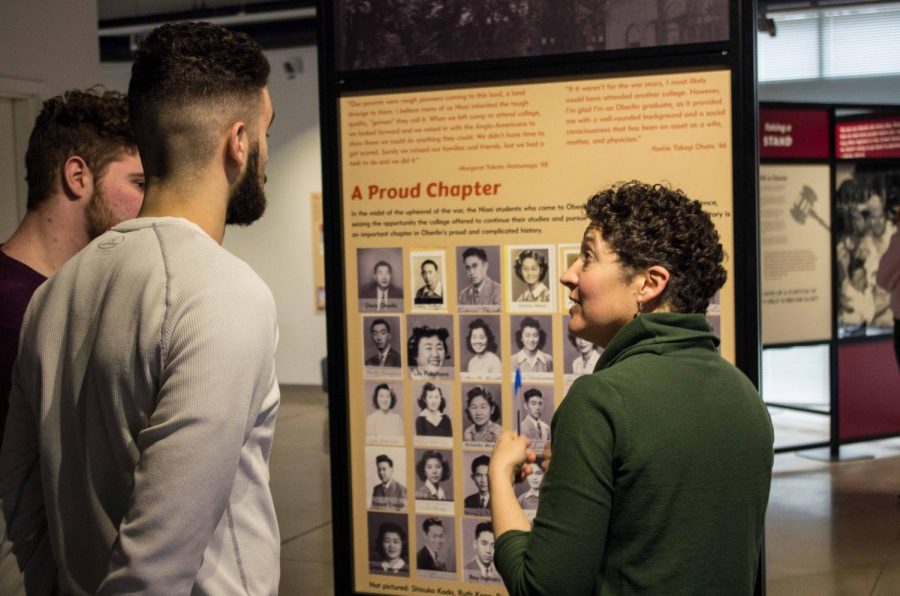Exhibit Highlights Japanese Internment Injustice
Professor Renee Romano discusses the nationally-touring exhibit “Courage and Compassion” with sophomores Justin Godfrey and Abe Kuhn.
“Courage and Compassion,” a historical exhibit that details national and local histories of Japanese Americans during World War II, opened at the Richard D. Baron ’64 Art Gallery last Saturday. Related lectures, film screenings, and concerts will run throughout the month, recounting the work of the local activists concerning Japanese-American incarceration during WWII.
The Go For Broke National Education Center — a Los Angeles-based nonprofit founded by Japanese-American veterans in the 1980s — is sponsoring the exhibit.
“We were fortunate enough to get a grant from the National Parks Service and the Japanese Confinement Project to fund a traveling exhibit to ten different cities in the U.S.,” said Dr. Mitch Maki, the director and CEO of the GFBNEC.
“Not only telling the generic story, but also allowing the local communities to tell their stories about how individuals — in this case at and around Oberlin and Oberlin College — stood up and showed courage and compassion in a time of crisis.”
Maki added that during WWII, Japanese Americans participated in the American war effort.
“We tell the story of what happened during WWII when [Japanese Americans] were incarcerated. This is not just a great Japanese-American story; it’s a great American story. These young men were doubted by their nation but say ‘we are Americans’ and prove it on the battlefield while their parents were behind barbed wire,” Maki said.
History Professors and Exhibit Directors Renee Romano and Shelley Lee are teaching a first-module course on memorializing and commemorating the history of Japanese-American incarceration.
“[The students] are serving as the docents at the exhibit and field-trip facilitators for local secondary and grade school students,” said Romano.
The College and city accepted Japanese-American students when they were forced to leave their colleges and universities on the West Coast and were sent to internment camps.
“From the perspective of professors and the College, it is a fabulously interesting story, and not that it hasn’t been talked about at all, but it’s not as well known as Oberlin’s history of anti-slavery activism,” Romano added.
The exhibit features a wide variety of archival materials and artifacts, including photographs, projections, application essays of Japanese-Americans students to the College, and copies of speeches by Japanese-American Oberlin students.
“President Wilkins [of Oberlin College 1927–1946] welcomed Japanese-American students when they were not allowed to attend other schools like UC Berkeley or UCLA, and students welcomed them, eventually electing Kenji Okuda, OC ’45, to serve on the student council,” Maki said. “Students even pooled their money for a barbershop to cut non-white hair, and it was run by a Japanese-American barber. Today that sounds pretty cool, but in 1943, it was unheard of.”
Oberlin community members, alumni, and current Oberlin students played a vital role researching for the exhibit.
“I got involved my first year, and people weren’t really sure the exhibit was actually going to happen, but it did,” said College junior and participating student Mackenzie Lew. “It was really cool to see it get funded and come to Oberlin. I’m pretty sure one of the documents I found in the archives in Mudd upstairs is in the exhibit.”
When the exhibit was confirmed, Asian-American alumni contributed their stories. “At every step, the response has been above and beyond our expectations,” Romano said. “One of the moments where we were just blown away was with an alum named Clyde Owan, [OC ’79]. When we contacted him, he said ‘I’m gonna contact other alums,’ and we got immediate offers: ‘I have my granddad’s diary, I have this, I have that.’ We were just amazed.”
In addition to the exhibit at the gallery, there are various events in the next month, which are all free and open to students and the public.
One such event is a performance and lecture from San Jose Taiko in Finney Chapel at 7:30 p.m. tomorrow.
“I’m really excited,” Lew said. “Taiko moved into the mainstream because of third-generation Japanese Americans whose parents were interned. It was used as a way to reclaim that cultural pride, and it was only through their work and connection to incarceration that it became so popular.”
93-year-old Alice Takemoto, OC ’47, will also return to campus to give a concert March 7. Takomoto graduated from the high school at the Drome incarceration camp and entered the Oberlin Conservatory to study piano when she was 16 years old.
Maki said that “Courage and Compassion” tells an important story of American people throughout their challenges in the war and how those challenges continue today.
“The United States government went across the nation collecting testimony,” Maki said. “They came out with their findings and said the internment was wrong, and attributed to wartime hysteria, racial prejudice, and failure of political leadership. These three terms apply today. We are at war with terrorism, prejudice still exists, and Congress has trouble doing anything not along party lines. We need to go beyond this, working together for the greater good.”
Romano added that the exhibit is relevant in the face of political issues like immigration and refugee policy.
“What’s inspiring is that there are people in every historical era who stand up for what they believe to be right, and refuse to simply accept stories that are based on no evidence and that are just fear mongering, that are based in racial prejudice, and say that this cannot stand,” she said.
The “Courage and Compassion” exhibit is open Saturdays from 10 a.m. to 5 p.m. and Sundays from noon to 5 p.m. The exhibit and the events to follow are free and open to both students and the public. “Courage and Compassion” is also visiting Honolulu; Chicago; Albuquerque, NM; Kingsburg, CA; Minneapolis; Rochester, MN; Monterey, CA; Peoria, IL; and Salem, OR, on its tour.






